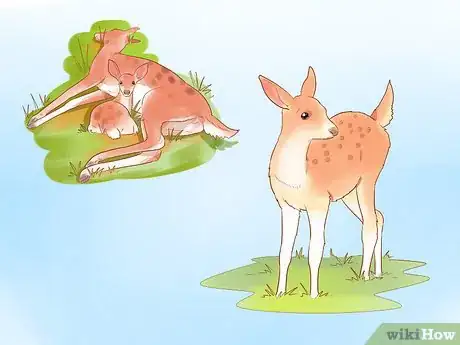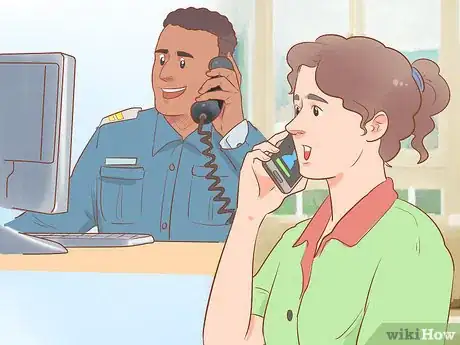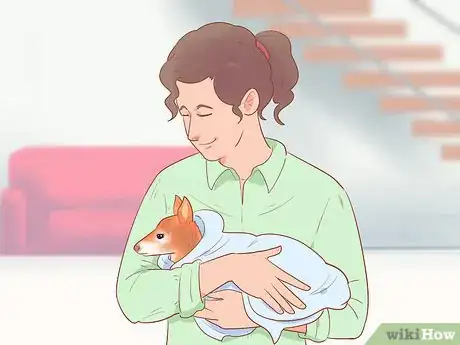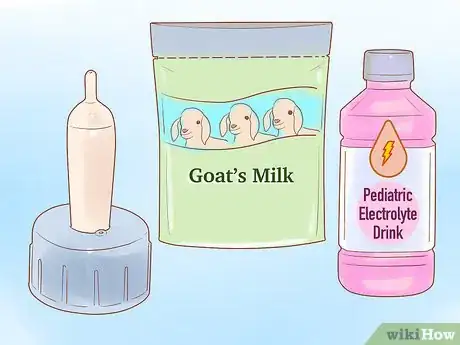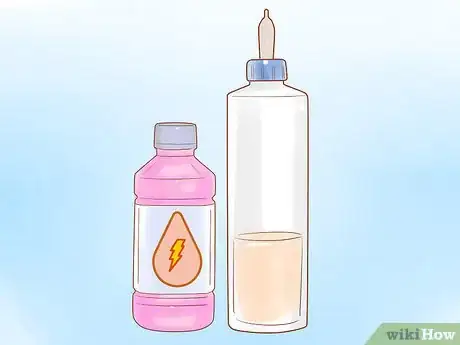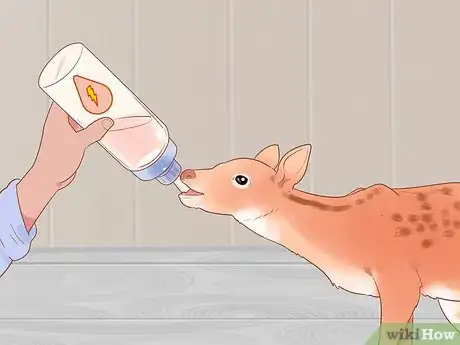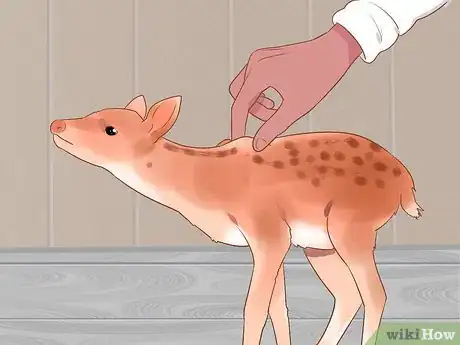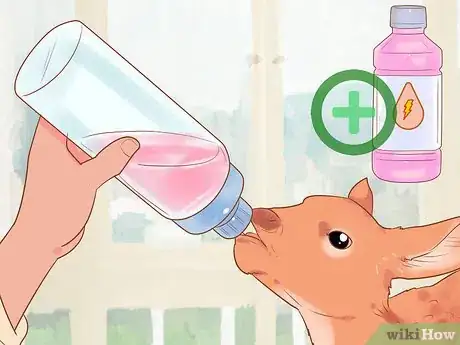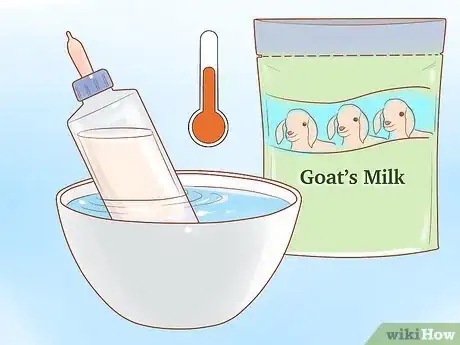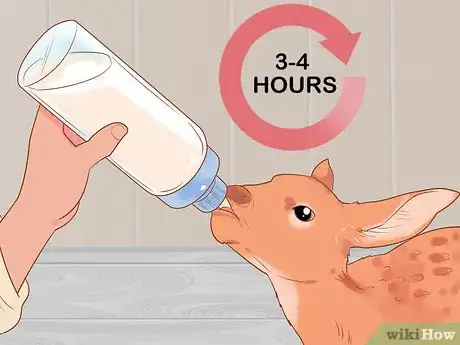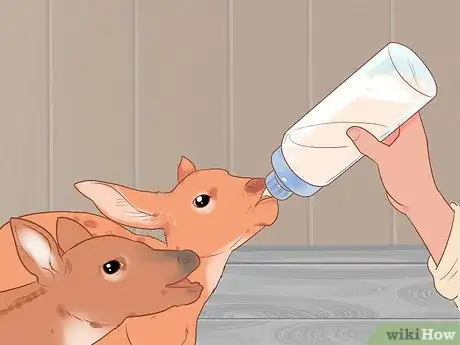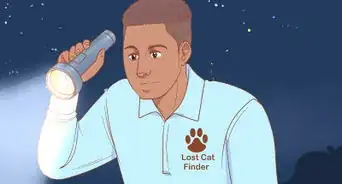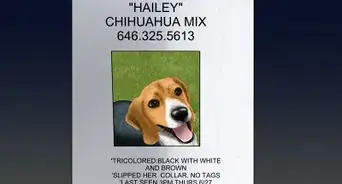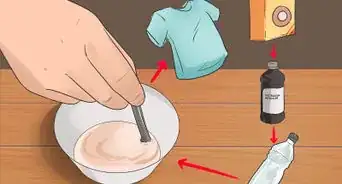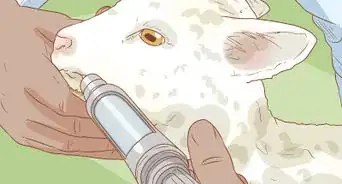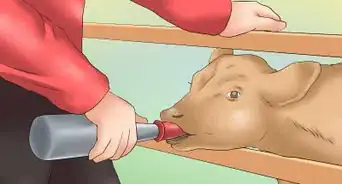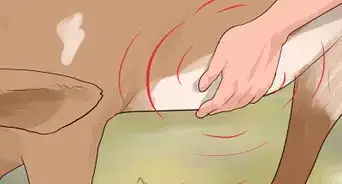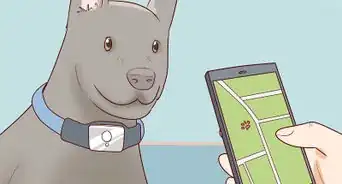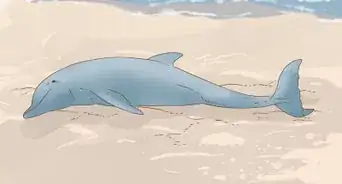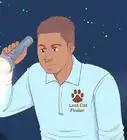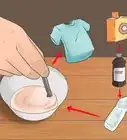This article was co-authored by Ryan Corrigan, LVT, VTS-EVN and by wikiHow staff writer, Christopher M. Osborne, PhD. Ryan Corrigan is a Licensed Veterinary Technician in California. She received her Bachelor of Science in Veterinary Technology from Purdue University in 2010. She is also a Member of the Academy of Equine Veterinary Nursing Technicians since 2011.
There are 8 references cited in this article, which can be found at the bottom of the page.
wikiHow marks an article as reader-approved once it receives enough positive feedback. In this case, 95% of readers who voted found the article helpful, earning it our reader-approved status.
This article has been viewed 136,925 times.
If you see a baby deer (fawn) all alone in the wild, assume it’s healthy and its mother is nearby unless you have clear evidence to the contrary. Then, and only then, you should take action. Contact a wildlife rehabilitator and follow their instructions, which may include bottle-feeding the fawn an electrolyte drink for hydration, and later goat’s milk or a milk substitute for nutrition.
Steps
Providing Immediate Assistance
-
1Leave a healthy-looking fawn alone unless you’re sure it needs help. Just because you see a fawn by itself at the edge of the woods, that does not mean it’s an orphan that needs your help. In most cases, the fawn’s mother is likely hiding nearby, and you’ll do more harm than good by trying to provide unnecessary assistance.[1]
- If you know the fawn’s mother is deceased—for instance, because you see its body nearby—or the fawn is visibly injured or very frail-looking, then you can assume it is an orphan in need.
- If you’re not sure, and you’re able to observe the fawn, keep an eye on it regularly for at least 6 hours. If you never see the mother during this time, it’s increasingly likely that the fawn is an orphan.
-
2Contact a wildlife rehabilitator before taking action. Unless the fawn is in immediate danger, take a few minutes to get in touch with a professional wildlife rehabilitator before you do anything. They can guide you through the best way to respond (or not respond), and may ask for you to wait for them to arrive.[2]
- To find a wildlife rehabilitator in your area, call your government’s department for the environment, natural resources, and/or wildlife, or use websites such as https://ahnow.org/#/ and https://www.humanesociety.org/resources/how-find-wildlife-rehabilitator.
- If the fawn is standing on a busy roadway, for example, take action before calling the wildlife rehabilitator.
Advertisement -
3Use a heavy blanket to transport the fawn to a safe, warm location. If the wildlife rehabilitator advises you to leave the fawn in place, do so. Otherwise, wrap a heavy blanket over the fawn’s shoulders and legs and carefully pick it up. Even small fawns can pack a powerful kick, so hold it securely![3]
- If you’re near home, for example, you might carry it to your garage.
- It’s not advisable to put a fawn into a vehicle unless: you have no other way to get it to an animal rehabilitator, the rehabilitator recommends it, and your vehicle has ample space inside.
-
4Pick up the feeding supplies you’ll need. Don’t try to use baby bottles, and especially not cow’s milk, to feed a fawn. And don’t try to bottle-feed the fawn at all unless specifically directed to do so by the wildlife rehabilitator. You’ll need the following supplies, many of which you’re most likely to find at a feed store or other retailer that services the farming industry:[4]
- Goat/lamb bottle-feeding nipples, which usually will fit onto plastic water bottles (if not, get feeding bottles as well).
- Goat or wildlife milk replacer (which you add to water), or goat’s milk. Do not use cow’s milk.
- Pediatric electrolyte drink (e.g., Pedialyte) for dehydration in children (you can get this at any drugstore or grocery store).
Hydrating a Fawn by Bottle
-
1Add 2–4 fl oz (59–118 ml) of a pediatric electrolyte drink to a bottle. If, when the fawn is standing, its shoulder is roughly even with your knee, it will likely drink this amount per feeding. If it’s an older, larger fawn (up to around your waist), increase the amount to 4–6 fl oz (120–180 ml).[5]
- A wildlife rehabilitator--who you should contact before offering any care--will probably tell you to provide electrolytes for hydration before giving the fawn any milk. If they give you different advice, however, trust their expertise and follow their directions.
- Use an empty, clean water bottle, soda bottle, or similar bottle that a goat/lamb feeding nipple fits onto.
- Any flavor of pediatric electrolyte drink will work.
-
2Warm the bottle until the drink is roughly body temperature. Place the filled bottle into a mug or bowl of hot tap water for 5-10 minutes, until the liquid inside the bottle is approximately 98–100 °F (37–38 °C). You don’t have to precisely measure the temperature, though—if the bottle feels warm to the touch but isn’t uncomfortable to hold, it should be fine for feeding.[6]
- Don’t place the bottle in boiling or near-boiling water to heat it faster, as this can damage the nutrients in whatever liquid is inside—in this case, pediatric electrolyte solution, but also goat’s milk or milk replacer.
-
3Dribble some liquid on the fawn’s lips to encourage it to drink. Face the fawn and bring the bottle down at an angle from above. Touch the bottle nipple to its lips and squeeze gently to drip some of the liquid between the lips. This usually spurs the fawn to latch on to the nipple and start sucking.[7]
- If the fawn is too weak to feed or otherwise refuses, let the wildlife rehabilitator know.
-
4Hold the bottle high so the fawn has to look up to drink. Keep the bottle raised up so the fawn has to extend its neck and mouth to reach it. This might appear uncomfortable, but it’s the natural feeding position for a fawn. Allow it to feed until the bottle is empty or it loses interest in continuing.[8]
-
5Pinch the skin between the fawn’s shoulder blades to check for hydration. About 1 hour after giving it the first bottle of pediatric electrolyte drink, use 2 fingers to pinch the skin between its shoulder blades. If the skin drops immediately when you let go, the fawn is adequately hydrated. If the skin remains pinched up briefly after you let go, the fawn is still dehydrated.[9]
- This is called a “skin turgor” test and is useful in checking for dehydration in many kinds of animals.
- Conduct this test only if advised to do so by the wildlife rehabilitator. If they'll be arriving soon to evaluate the deer, they may want to conduct the test.
-
6Give additional electrolyte bottles if directed by the wildlife rehabilitator. Based on the results of the "skin turgor" test, the wildlife rehabilitator may request that you give the fawn one or more additional bottles of pediatric electrolyte solution. If so, you'll likely be advised to give a bottle every 1-2 hours, and to conduct the skin turgor test in between each bottle.[10]
- Once the fawn is adequately hydrated (based on the skin turgor test), the wildlife rehabilitator may ask you to start feeding the fawn goat's milk or a milk replacer.
Switching to Milk for Bottle-Feeding
-
1Warm 2–4 fl oz (59–118 ml) of goat’s milk or milk replacer in the bottle. If you’re using goat’s milk, just pour it into the bottle. With milk replacer, you’ll need to measure and add the powder to the amount of water in the bottle, screw on the goat/lamb nipple and pinch it shut, then shake the bottle vigorously to combine.[11]
- Warm the bottle contents to body temperature by placing the bottle in a bowl of hot tap water. Hold the bottle in your hand to estimate when it reaches body temperature (a precise measurement isn't necessary).
- Use 2–4 fl oz (59–118 ml) for a knee-high fawn (based on its shoulder height when standing), and 4–6 fl oz (120–180 ml) for a waist-high fawn.
- Don't start giving a fawn milk unless expressly requested to do so by a wildlife rehabilitator. In most cases, they'll either advise not to offer anything by a bottle or to start with a pediatric electrolyte drink.
-
2Feed the fawn a full bottle every 3-4 hours. Fawns typically need to feed 6-7 times per day, so plan on spacing out feedings every 3-4 hours until the wildlife rehabilitator arrives. Approach the fawn from the front and above, dribble some of the milk between its lips so it latches on to the nipple, and hold the bottle high as it drinks.[12]
- Make sure you’re keeping the bottle elevated so the fawn has to stretch its neck and head to reach it—this replicates feeding from its mother.
- If the fawn bleats for more milk right after a feeding or between feeding times, ignore it—fawns will drink until they make themselves ill if permitted to do so.
-
3Stimulate the fawn's bowels while feeding it, if necessary. Fawns often need help stimulating urination and defecation. If it's not urinating or defecating during or after feedings, put on rubber gloves and gently rub a baby wipe (or damp cloth you don’t mind ruining) over its anus and genitals. A bowel movement will typically follow soon after.[13]
- This maneuver replicates the bowel stimulation the mother achieves through licking.
- If the fawn still isn’t defecating and urinating, or if it has diarrhea, contact the wildlife rehabilitator again.
-
4Limit bonding by feeding fawns in groups, if possible. Every time you feed a fawn, it will bond with you a little more and become less able to successfully return to the wild. If you happen to have more than one fawn that needs care, feeding them simultaneously—feeding 2 at a time with a bottle in each hand, for instance—will slow down the bonding process.[14]
- Think very carefully before deciding you want the fawn to bond with you and become your pet. Keeping a wild deer as a pet may be illegal where you live, and raising a fawn to adulthood requires a great deal of effort and about $500 USD in expenses.[15]
Warnings
- Contact an animal rehabilitator quickly when dealing with young fawns. They are quick to attach to a caretaker and, once imprinted, they are difficult to release back into the wild.⧼thumbs_response⧽
- A fawn should not be fed cow's milk. Actually, no animal aside from a cow should be fed cow's milk. It can cause colic and is often detrimental to the animal as, unlike humans, they have not developed a tolerance to foreign milk.⧼thumbs_response⧽
Things You’ll Need
- Goat/lamb bottle-feeding nipples
- Clean plastic bottles
- Pediatric electrolyte drink
- Goat milk, or milk substitute for goats or wildlife
- Heavy blanket
References
- ↑ http://wp.auburn.edu/deerlab/wp-content/uploads/2014/05/62Ext2011-Fawns.pdf
- ↑ https://www.ncwildlife.org/injured-wildlife
- ↑ https://www.peta.org/issues/wildlife/wildlife-emergencies/
- ↑ http://wildliferehabilitators.org/deer.html
- ↑ https://feedingnature.com/what-do-baby-deer-eat/
- ↑ https://www.wildwatch.org/firstaid/feeddeer.htm
- ↑ https://animals.mom.me/how-to-bottle-feed-an-orphaned-fawn-12132197.html
- ↑ https://feedingnature.com/what-do-baby-deer-eat/
- ↑ https://feedingnature.com/what-do-baby-deer-eat/
- ↑ http://wildliferehabilitators.org/deer.html
- ↑ http://www.nadefa.org/articles/fawn-care-guidelines
- ↑ https://animals.mom.me/how-to-bottle-feed-an-orphaned-fawn-12132197.html
- ↑ http://www.nadefa.org/articles/fawn-care-guidelines
- ↑ http://wildliferehabilitators.org/deer.html
- ↑ http://wp.auburn.edu/deerlab/wp-content/uploads/2014/05/62Ext2011-Fawns.pdf
About This Article
If you need to bottle-feed an orphaned fawn, pour warm goat’s milk or wildlife milk replacer into a water bottle and attach a goat or lamb bottle-feeding nipple. Use 2-4 fl oz for a fawn that’s knee-high or 4-6 oz if it’s waist-high, and give it a bottle every 3-4 hours. However, keep in mind that in most cases, you should leave a fawn alone, since its mother is likely hiding nearby. If you’re sure the fawn is orphaned, call a wildlife rehabilitator, and only attempt to bottle-feed it if the rehabilitator tells you to. For tips on getting the fawn to safety, keep reading!
